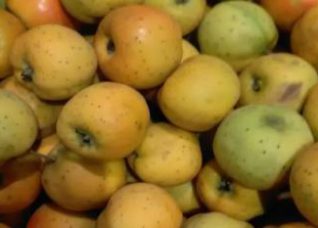
MinerAlert

MinerAlert
Crataegus mexicana
Rosaceae
Texocotl.
“Raíz de tejocote”, Manzanita, Manzana de Indias, Tejocotera (Johnson, 1999; White, 2003).

Certain advertisements on the Internet mention the root, although apparently only the dried fruit is shown. Additionally, other plants and compounds may be included as part of a mixture. One internet site that markets a purported weight loss supplement mentions the capsules of Mexican hawthorn “root” also contain other ingredients such as oat bran, oatmeal, flax seed, and cactus (Alipotec, 2016).
Mexican hawthorn is a medium-sized tree native to Mexico and Central America (Quattrocchi, 2012; Mabberley, 2017). The leaves and flowers of other species of hawthorn, such as white hawthorn (Crataegus oxyacantha), for example, are used in Europe for the treatment of congestive heart failure (Bone and Mills, 2013).
The fruits, but not the root, of this tree have long been used in Mexican traditional medicine for the treatment of various ailments, especially for coughs, to promote urination (as a diuretic), and respiratory problems (Johnson, 1999; Mendoza-Castelán and Lugo-Pérez, 2011; Argueta, 1994).
However, the use of the root taken as capsules has only recently been touted as a slimming agent. The root used for weight loss does not appear in most publications about medicinal plants from Mexico (Márquez-Alonso et al., 1999; Mendoza-Castelán and Lugo-Pérez, 2011; Argueta, 1994; Martinez, 2011), and only one source mentions it as a treatment for weight loss, but taken as a tea, (not in capsules) and in combination with other medicinal plants (Argueta and Zolla, 2014).
A video available over the internet mentions the root as the main ingredient in the formulation, but shows only the fruit of the plant, not the root. This form of advertising can be misleading and confusing to the consumer, as it is not clear what is contained in the supplement. Additionally, it mentions that the supplement also includes both non-herbal components, as well as various other botanical ingredients (oat bran, oatmeal, flax seed, and prickly pear cactus), for example (Alipotec, 2018).
One commercial site (www.alipotecus.com) recommends taking the capsules and drinking 2-3 liters of water per day, along with ingesting fruits and vegetables that are rich in potassium. The initial treatment recommended by the company has duration of 3 months.

Photo: Tony Rodd/Google images
Mexican hawthorn tree, fruits and leaves
The dried and pulverized fruit of the plant is taken in capsules as a purported weight loss supplement, as well as to treat various ailments. Various statements that could be interpreted as health claims are mentioned in certain websites that advertise the capsules. According to a company’s websites in English and Spanish, taking “raíz de tejocote” or Mexican hawthorn “root” capsules (apparently containing the dried and pulverized fruit, among other compounds) has a plethora of purported beneficial effects including “reducing weight and obesity by eliminating body fat”, “cleansing and detoxifying the body”, “softening and liberating fat from muscular tissue-via de natural excretions of the body”. The site also states, “elastin and collagen are kept intact, since this product does not destroy muscle tissue cells, allowing the skin to recuperate its firmness” (www.alipotecus.com, www.alipotec.com).
Various other unsubstantiated statements seem to be very specific medical claims, including “there is reduction in knee pain, arthritis, arthroses, and diseases of the heart”. The supplement supposedly “lowers cholesterol and triglyceride levels in the blood”, “reduces the risk of colon cancer” and “improves intestinal function”, “eliminates hard fat and reduces cellulite”, “tones muscles and allows skin to recuperate firmness”.
Furthermore, the site mentions this supplement “significantly reduces food anxiety, “alleviates hemorrhoids and constipation”, as well as “can also lower blood pressure, and as blood sugar levels”. However, as stated before, there are no known published clinical trials to ascertain its effectiveness for any of the aforementioned claims, nor for treating any disease or health condition in humans.
One of the sites (www.alipotecus.com) and its YouTube™ videos in both English and Spanish (Alipotec, 2018), mention that the “Raíz de Tejocote” (Mexican hawthorn root) “is approved by the Food and Drug Administration (FDA) of the United States”, and feature the official FDA logo. However, a search within the official FDA website using the keywords in English and Spanish: “crataegus”, “tejocote”, “raiz de tejocote”, “Mexican hawthorn root”, and “alipotec” did not reveal any evidence to confirm this statement (FDA, 2019).
Safety/Precautions:
Before you decide to take any medicinal herb or herbal supplement, be sure to consult with your health care professional first. Avoid self-diagnosis and self-medication: Always be on the safe side!
Alipotec - Raíz de Tejocote. Sales and Distribution Center. (United States).
https://www.alipotecus.com/ retrieved February 7, 2018.
Alipotec. https://www.alipotec.com/ retrieved February 6, 2018.
Alipotec-Raiz de Tejocote video.
https://www.youtube.com/watch?v=3gkRr-FO2b4 retrieved February 4, 2018.
Argueta A. Atlas de la Medicina Tradicional Mexicana (Vol. 1).
México, D.F.: Instituto Nacional Indigenista; 1994.
Argueta A, Zolla C. Plantas Medicinales de Uso Tradicional en la Ciudad de México.
México, D.F.: UNAM; 2014; pp. 109-110.
Bone K, Mills S. Principles and Practice of Phytotherapy 2nd Ed.
London: Churchill Livingstone; 2013.
El mundo en línea. Raíz De Tejocote – Efectos Secundarios y Riesgos Médicos
http://elmundoenlinea.com/raiz-de-tejocote-efectos-secundarios-y-riesgos-medicos.html retrieved December 19, 2016.
United States Food and Drug Administration (FDA) official website:
https://www.fda.gov/consumers/articulos-en-espanol/cuidado-con-los-productos-que-prometen-una-reduccion-de-peso-milagrosa, retrieved July, 15, 2019.
Johnson T. CRC Ethnobotany Desk Reference.
Boca Raton, FL.; CRC Press; 1999; p. 236.
Mabberley D. Mabberley’s Plant Book 4th ed.
London: Cambridge University Press; 2017; p. 244.
Márquez-Alonso C, Lara-Ochoa F, Esquivel-Rodríguez B, Mata-Essayag R.
Plantas Medicinales de México II. México, D.F.: UNAM; 1999; p. 157.
Martínez M. Las Plantas Medicinales de México.
México, D.F.: Sociedad Herbolaria de América, A.C.; 2011; pp. 300-301.
Mendoza-Castelán G, Lugo-Pérez R. Plantas Medicinales en los Mercados de México.
Chapingo, Estado de México; Universidad Autónoma Chapingo; 2011.
Quattrocchi, U. World Dictionary of Medicinal and Poisonous Plants (Vol.1).
Boca Raton, FL: CRC Press; 2012.
White R. Elsevier’s Dictionary of Plant Names of North America Including Mexico.
Amsterdam: Elsevier; 2003.